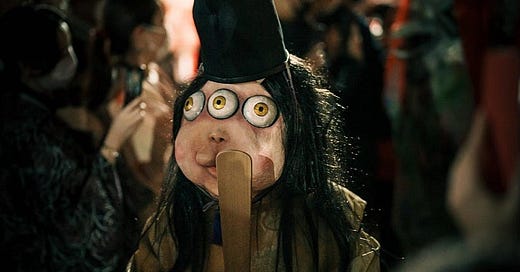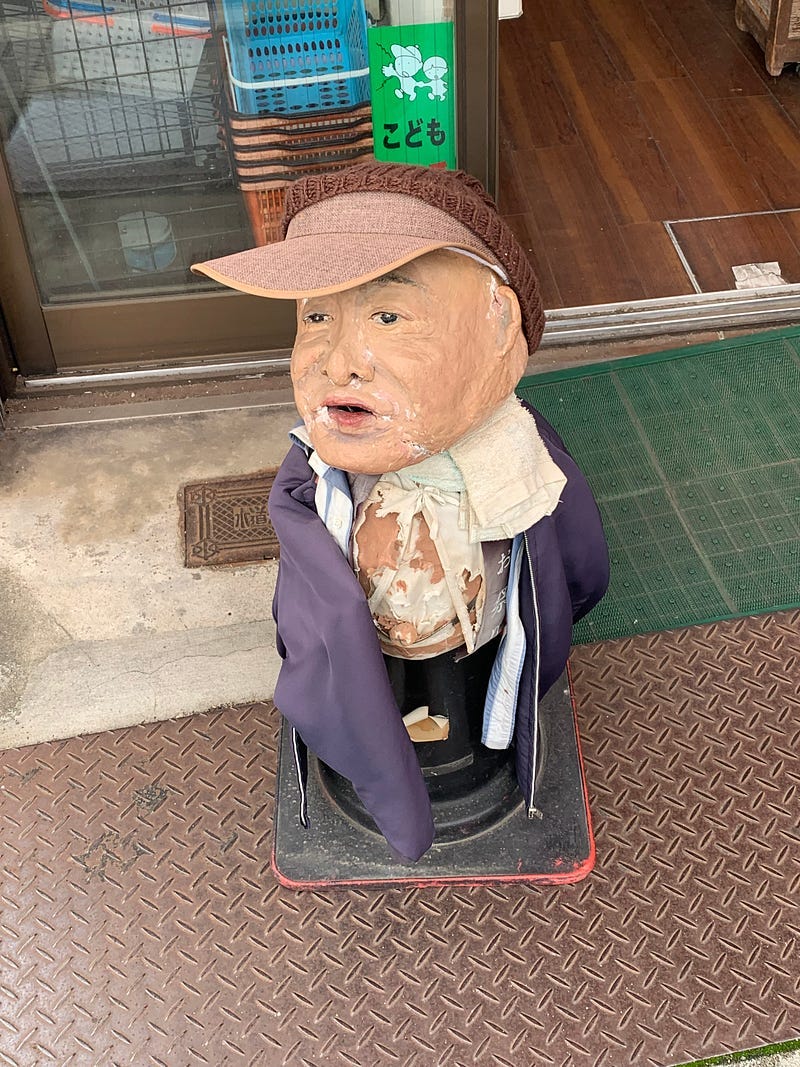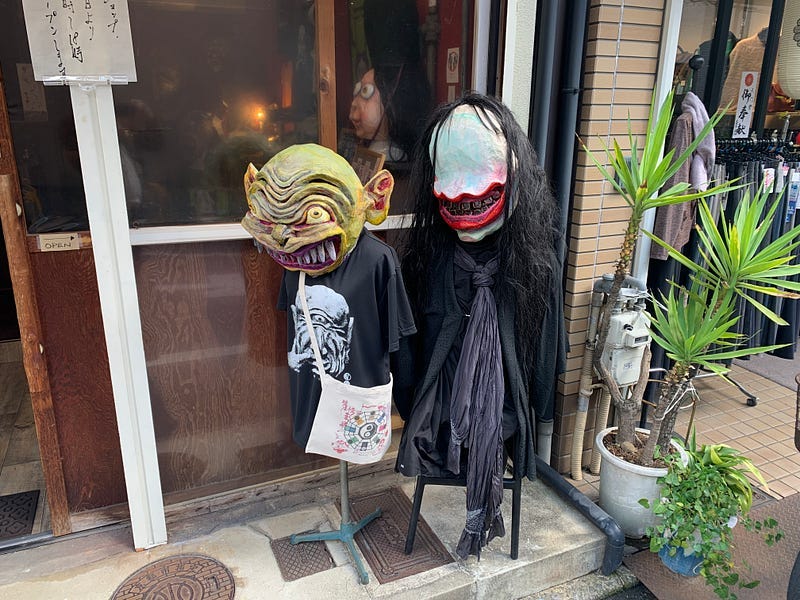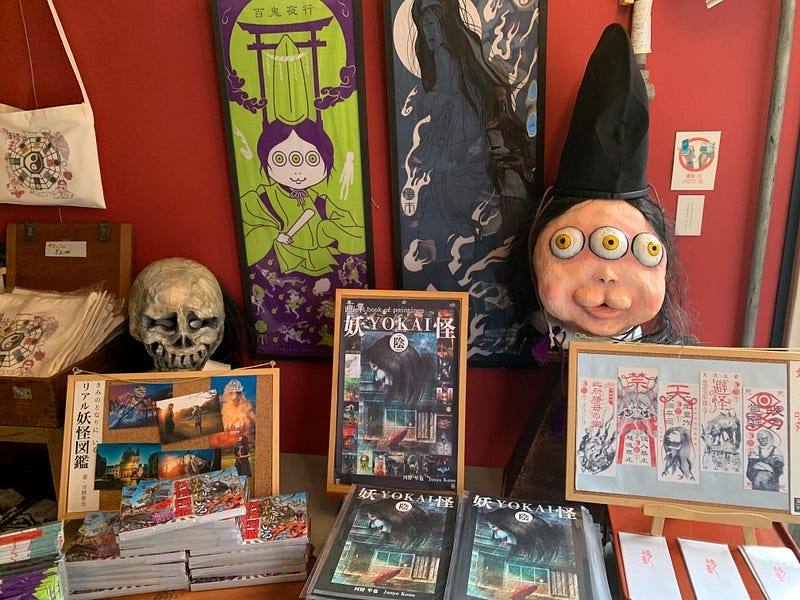Celebrate Kyoto's Hidden Street of Monsters and Ghosts
Visit Taishogun, the "yokai street" of Kyoto.
Tucked away in some unassuming corner of Kyoto, is a street dedicated to demons and the underworld.
These demons, known as yokai (妖怪) in Japanese, can refer to any supernatural being ranging from ghosts, monsters, devils, basically anything not of this world. They can be evil, good, or neutral.
Located in the northern part of the city, on Taishogun Shopping Street, you’ll find that most shops have their own personal yokai outside of their entrance.
These creatures are handmade, sometimes resembling actual Japanese folklore monsters, sometimes just whatever the owners randomly jumbled together.
When I arrived, there wasn’t anything going on. Most shops were closed, as is the case on weekends. There were a few elderly people selling fish and chatting on the side of the road. The place looked like a sleepy, relaxing, and unpopular kind of place where people lived instead of doing business.
That calm atmosphere changes once a year.
Every year in October (although the date has now changed to April) thousands of people gather and dress as monsters and parade through the streets.
This has nothing to do with Halloween, the origins go back much further.
The Legend
The local story goes that over 1,000 years ago residents of Kyoto threw out their unwanted tools. There was a belief that if a tool lasted 100 years, it would start to come alive, and if you wanted to get rid of it you had to do a proper ritual. If not, the tools would turn into demons.
The tools were so angry that they were carelessly discarded that they transformed into vengeful creatures and started to terrorize the city.
One night, they gathered in Taishogun to thank the “god of change” in a parade of 100 demons, thus the “100 demon parade,一条百鬼夜行” was born.
Today people recreate that procession every year. The rules for dressing up are:
The costume has to be handmade.
You can’t show gore or blood.
Your look can’t resemble an existing character in media (to not get sued but also to encourage creativity).
During the festival there’s a ghost market (Mononoke Ichi) selling things like eyeball earrings, ghost sake, stuffed demon dolls. Most of the shops on the street also sell monster themed products throughout the year as well. I saw Tengu ramen and zombie croquette, with some skeleton cloth material for kimono.
Using Horror to Revitalize a Town
The festival isn’t one that has been celebrated every year for the last millennium. Its a recent event spearheaded in 2005 by the Yokai Art Group Hyaku-yo-bako, which at the time was comprised mainly of university students.
The area was declining as most shop owners are elderly and there wasn’t any reason for people to come and visit. The Yokai Group approached the tenants of the shopping street with the idea of tapping into the ancient legend of the 100 demons to revitalize the economy.
And its working, at least to an extent. Many places in Japan are in decline. The population is getting older, and if with not too many young people to replace them; or anyone to go out and buy things; many shopping arcades fall into disrepair.
In Taishogun, the yokai festival isn’t going to save the economy whole sale. However, it does draw in more customers than they would get otherwise.
On the night of the festival, 1,000s of people descend to join in the fun. And with them comes their money. Residents were initially not wanting to put “weird” monsters in front of their stores, but after seeing the draw of visitors they helped bring in, most people have changed their minds.
The main guy behind everything is Junya Kono, lecturer at Kyoto Saga University of Arts.
I randomly walked into Junya’s store without any knowledge of who he was or how he was connected to the area. His place is called the ‘100 ghost box” store, or 百妖箱妖怪キャラリーショップ as you would find it in Japanese. Here’s the address.
His place is small, with some homemade yokai masks you can try on for free. He also sells monster themed shirts, posters, stamps, and an art book with both English and Japanese captions he made himself. You can see his book in the above image, in the center, titled “YOKAI”.
If you request it of him beforehand, you can even book a traditional “kaidan 怪談”, a ghost story where all the lights are turned off save for a few candles, and Junya recounts either actual folklore tales or ones of his own making.
Junya had incense burning in the store. In the back room I could see cryptic symbols, almost like pentagrams, written on traditional fans. He is nice, talkative, and passionate. He wore a traditional Japanese dress a man from the 1800’s may have well.
Junya is an absolute lover of all things yokai. He travels to the US every year to hold yokai events and spread the good word. He is also the main guy who started the whole demon parade festival.
All that to say, if you want to know anything about yokai in general, or about this street in particular, Junya is your man.
He was easy enough to talk to. We exchanged our favorite Japanese horror movies, mine being Noroi 呪い (The Curse) and his being some obscure title even for me and I couldn’t understand the name of it.
I bought his art book, which details dozens of yokai with some cool artwork for each. the English has some misspellings, but Junya’s passion is so obvious I felt like I should support him. The incense he burns all day in the shop have fused with the book, so whenever I open it I’m transported back to his sanctuary of the supernatural.
Should you Visit?
To be honest, the only reason to visit Taishogun is if you want to go to Junya’s shop and talk to him about horror, or local folklore. If that’s your thing, you’ll find value in it.
Other than that, you can see the unique monster designs each shop has on their sidewalk. But if the stores are closed, as most were when I went, you won’t see many of them.
The time to visit has to be for the demon parade in April. There’s also a smaller dress up event in November in Fushimi-ward, southern Kyoto. Other good options would be to see the ghost flee market held four times a year.
Check the official website here for details, be warned it is all in Japanese.
Whether you see the yokai parade of Kyoto or not, knowing the folk traditions and beliefs of the people of ancient Japan is worth the trip this Halloween season.








Sounds fascinating. Have you ever read Michael Dylan Foster's books on yokai?
I've used them as a key resource in my Pokémon series.